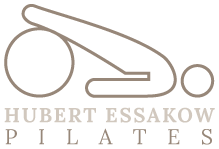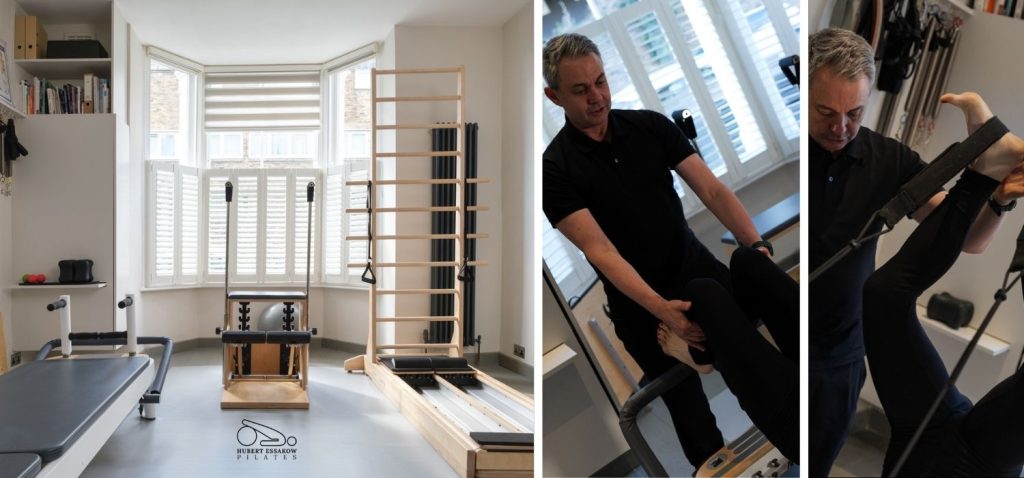1. Introduction: Back Pain in Everyday Life
If you’ve ever found yourself wincing as you get out of bed, bracing your hand against the wall as you try to stand upright, or shifting constantly at your desk to find that one “comfortable” position—then you’re not alone. Back pain has a way of creeping into the background of daily life until it starts calling the shots.
Over the years, I’ve worked with people from all walks of life—parents juggling school runs and supermarket bags, freelancers hunched over laptops at kitchen tables, and retirees who just want to garden or walk without pain. The common thread? That familiar, frustrating tightness in the lower back or shoulders. Sometimes it’s dull, sometimes it flares. But it’s almost always there.
And while most people are quick to try stretching apps, foam rollers, or a few painkillers to get through the day, very few have heard of Reformer Pilates as a long-term approach to managing back pain. It’s not flashy. It’s not a miracle cure. But when done right, it can offer something most solutions don’t: steady, sustainable relief that actually gets to the root of the problem.
In the sections ahead, I’ll walk you through what really causes most back pain, how Reformer Pilates works on a deeper level, and what it looks like to build strength, confidence, and comfort in your body again—no matter where you’re starting from.
2. Understanding Back Pain: Not Just About the Spine
Back pain is rarely just about the spine itself. In fact, most of the time, it’s not even about a single injury or event. What I see more often is a slow build-up of habits and patterns—things like poor posture, long periods of sitting, weak core muscles, or even the way someone carries stress in their body.
Sometimes a client will tell me, “I didn’t even do anything! I just woke up one day and it hurt.” And I believe them. It’s not always easy to pinpoint why it hurts—only that it does.
Pain is complicated. It can stem from years of compensating for an old ankle injury, or favouring one side when carrying children. It can come from a weakened core that’s no longer supporting the spine properly, or from being stuck in one position for too long, day after day. Even emotional stress has a way of showing up in the body, especially around the neck, shoulders, and lower back.
And yet, when the pain kicks in, we often reach for the fastest fix—stretch it out, take something for it, try a new gadget. It’s completely understandable. But I’ve found that those quick fixes rarely last, because they don’t change what’s actually happening in the body.
That’s where Reformer Pilates comes in—not as another short-term solution, but as a way to rebuild the foundation. It’s about understanding your body’s patterns, gently re-educating movement, and giving your spine the support it needs from the ground up.
3. Why Reformer Pilates Works for Back Pain
What I really appreciate about Reformer Pilates—especially when someone’s in pain—is how gentle it is. You’re not forcing anything. You’re not being told to push through. It gives your body a way to move that actually feels safe.
The machine itself—the Reformer—might look a bit strange at first, but it’s incredibly supportive. You’re lying down for most of it, working against springs instead of lifting weights or putting pressure on sore joints. That alone makes a huge difference for someone whose back has been flaring up from just doing daily tasks.
When we use the Reformer, we’re not just moving—we’re teaching the body how to move better. That means waking up the deep core muscles, the ones that quietly support the spine and help you hold yourself upright. If those aren’t doing their job, the lower back often takes over. And over time, that compensation starts to hurt.
Reformer work is also brilliant for helping the spine feel longer and lighter. A lot of people live with this compressed feeling—like everything is squashed down. But the right movement can create a real sense of space in the body. I’ve had clients finish a session and say things like, “I feel like I can stand properly again.” That’s when I know their body’s starting to respond.
And what’s great is, everything we do can be scaled to match how you’re feeling that day. If your back’s tender, we slow it down. If you’re building strength, we nudge things forward. There’s no pressure to perform, no need to tick boxes. It’s just about moving in a way that helps your body trust itself again.
Over time, that trust builds. The pain eases. And your body starts to feel like somewhere you want to live in—not just get through.
4. How I Work With Clients Managing Back Pain
When someone comes to me with back pain, I don’t start by asking how flexible they are or whether they’ve done Pilates before. I want to know how they’re feeling in their body—what movements they avoid, where the tension shows up, what a typical day looks like. Often, it’s not just the pain that’s the issue. It’s the fear of making it worse.
So the first thing we do is slow everything right down. I assess how you move—how you stand, how you breathe, how your spine behaves when you try to bend or twist. From there, we start building a picture. It’s never a one-size-fits-all approach. Two people can have the same kind of back pain for completely different reasons.
In those early sessions, the focus is on reconnecting with your body in a safe, supported way. We’ll often begin with small, precise movements—engaging the deep abdominal muscles, encouraging length through the spine, and using the Reformer’s springs to guide rather than challenge. You’re never left guessing. I’m right there, adjusting things, making sure you feel secure, and helping you notice what’s happening in your body.
I think about one client who came in barely able to bend down to put socks on. He’d tried physio, seen a chiropractor, even bought one of those big back support belts. But nothing stuck. Over time, as we worked through the layers—tight hips, weak glutes, limited core engagement—he started moving with more ease. A few months in, he told me he’d picked something up off the floor without thinking about it for the first time in years. That moment mattered more than any number of reps or sessions.
Progress looks different for everyone. For some, it’s about reducing flare-ups. For others, it’s learning to trust movement again. I always remind clients that slow is not a setback—it’s where the real work happens. When your body feels supported, it begins to let go of the bracing and guarding that often makes the pain worse.
It’s not about chasing a perfect posture or ticking off a list of exercises. It’s about helping your body feel like it belongs to you again.
5. Real Outcomes: What Clients Often Notice
Back pain doesn’t vanish all at once. But when someone starts moving differently—when they feel supported, rather than just told to “fix their posture”—things begin to shift.
Most of the time, it’s not a dramatic moment. It’s subtle. A client might say, “I got through the whole day and barely noticed my back,” or, “I didn’t need to reach for anything after that long meeting.” Those small comments tell me their body’s calming down, and that trust in movement is starting to return.
Another thing I notice is how people carry themselves. Not in a forced, shoulders-back kind of way, but with more ease. They start to sit more comfortably, walk with a bit more confidence. There’s less tension in the way they hold themselves. It’s like their body isn’t bracing anymore.
Over time, the dependency on quick fixes—like painkillers or emergency physio appointments—tends to drop off. Not because I tell them to stop, but because they don’t need them as much. They’re more aware of how their body reacts to stress or long hours at a desk, and they’ve learned how to move through it instead of getting stuck in it.
One thing I hear often is, “I feel stronger,” not “I feel sore.” That always stands out. It means their body’s responding to the work, and they’re noticing what it feels like to move well.
And really, those are the wins that matter. Picking up the kids without thinking twice. Sleeping through the night. Getting out of a chair without the usual twinge. These aren’t flashy achievements—but if you’ve lived with back pain, you know how much they mean.
6. Is It Right for You? Knowing When to Start
If you’re waking up stiff most mornings, shifting around in your chair by mid-afternoon, or noticing that familiar ache every time you carry shopping or reach for something—your body’s already telling you it needs something different.
A lot of people wait until things get “really bad” before they try something new. I get it. It’s easy to brush off the signs, to tell yourself it’s just part of getting older, or that everyone feels like this. But the truth is, you don’t have to wait for a crisis to make a change.
One of the most common things I hear is, “I thought I had to be fit to do this.” You don’t. Not even close. Reformer Pilates is built to meet you exactly where you are. Whether your back has been troubling you for years, or you’ve just started noticing discomfort, there’s always a place to begin. And because it’s one-on-one, we go at your pace. Quietly. Gently. No pressure.
I’ve worked with clients who were nervous to even lie down flat on the machine at first. We started slowly, sometimes just focusing on breathing and small movements. And from there, we built something steady. That’s the beauty of it—it’s not about pushing through pain, it’s about building trust again.
So if something in your body feels off, or you’re just tired of feeling limited, you don’t need to have all the answers. You just need a place to start.
7. Final Word: A New Way to Relate to Your Body
The goal isn’t just to make the pain stop.
It’s to feel stronger. More upright. More at home in your body again.
Back pain has a way of changing how you move, how you sit, how you feel in your skin. It can chip away at confidence—make you second-guess simple things like tying your shoes or standing in a queue too long. But I’ve seen how things can shift when movement becomes something that helps, not something to fear.
You don’t need to be perfect. You don’t need to be flexible, or strong, or anything other than willing to start.
Reformer Pilates offers a different kind of pathway—one that doesn’t rush or push, but builds strength and ease in ways that last. If you’re tired of feeling stuck, or if you’re curious about what’s possible beyond just “managing” the pain, I’d love to help you explore it.
And if you have questions—even if you’re not sure where to begin—I’m always happy to chat. Sometimes the first step is simply a conversation.

